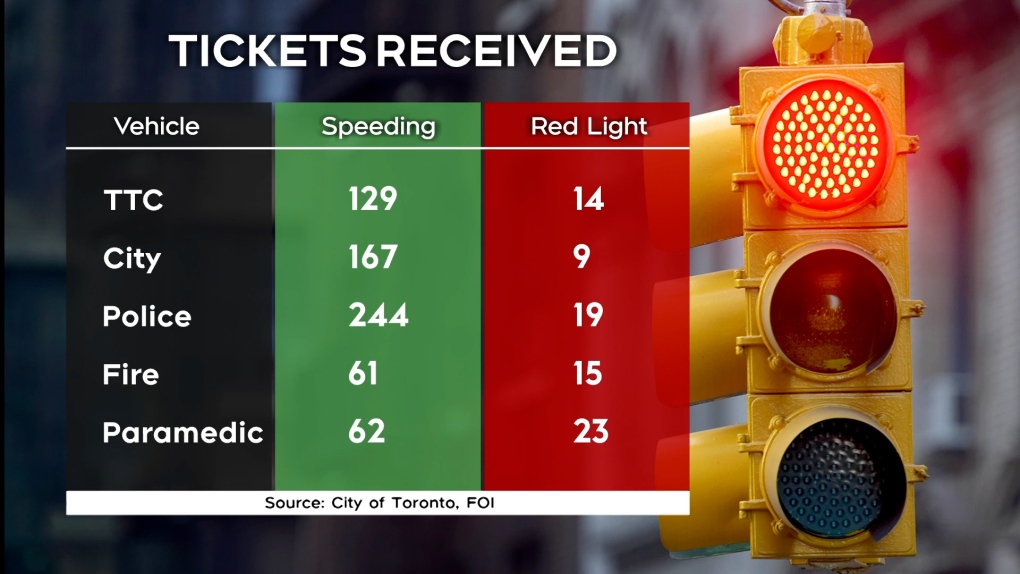City of Toronto-owned vehicles get automated tickets twice a day: investigation
City-owned vehicles, including buses, ambulances, fire trucks and police cars, have been ticketed for speeding and running red lights twice a day for the past year by Toronto’s automated enforcement system.
Data and tickets issued obtained by CTV News Toronto through a freedom of information request show pictures of buses, supervisor’s vehicles, and special constable cars speeding and running red lights, sometimes twice in one night.
Some drivers appear to be breaking traffic rules in the course of regular driving, while others appear to be getting tickets while on emergency calls — an unexpected side effect of the degree of automation writing hundreds of thousands of tickets a year requires.
“We want to catch anyone who is driving unsafely,” said Toronto City Councillor Shelley Carroll, who has been a proponent of the camera program as a route to reduce road fatalities.
“As it turns out, sometimes that’s our own employees,” she said.
TTC vehicles got 14 red light camera tickets in the past year, and 129 speeding tickets. City vehicles were issued 167 speeding tickets and nine red light tickets.
Police were issued 244 speeding tickets and 19 red light tickets. Firefighters were issued 61 tickets and 15 red light tickets.
Paramedics were issued 62 speeding tickets and 23 red light tickets.
That all adds up to 743 tickets in the past year — a rate of about two per day.

The volume is much higher than anticipated, Carroll said, but no one expected that drivers in Toronto in general would trigger upwards of 200,000 pictures taken by the cameras in a year.
“Every part of the process is automated. Not just the speed camera, but generating the tickets,” she said.
City employees receive the red light tickets and have to show that they were speeding as part of an emergency response to avoid paying fines that can be as high as $325.
“We receive red light and ASE [automated speed enforcement] tickets the same as any other person or entity in the city. We have developed a process in line with City policy that allows for any ASE tickets to be quashed if they are generated in response to an emergency incident, with sufficient documentation,” wrote Debbie Higgins, Deputy Fire Chief.
Breaking traffic rules can be deadly, and the same holds for city vehicles. One woman died when a TTC bus ran a red light back in 2013. A firefighter was charged with careless driving after a fire truck hit an 11-year-old girl last year.
Ontario’s Highway Traffic Act requires emergency vehicles come to a complete stop at a red light— so officers will pay any related tickets, officials said. The pictures are reviewed by a Provincial Offense Officer before the charge is laid, officials said.
Much of the time, the professional drivers have to worry about other drivers running reds or speeding, and the statistics bear that out. The 743 tickets make up less than half a per cent of the 196,363 speed tickets and the 67,119 red light tickets issued since July 1, 2020.
The automated speed cameras were installed as part of a push to lower the number of people dying on Toronto’s roads. But more effort is required than just ticketing people, said Amanda O’Rourke of 8 80 Cities, a non-profit that focuses on mobility and public spaces.
“We know speed kills,” she said, but added that drivers tend to pick a speed based not necessarily on the speed limit, but often on design features of roads meant to move vehicles at speed.
“We need to re-engineer our streets to prioritize vulnerable road users rather than prioritizing moving cars quickly,” she said.
That means bigger curbs, narrower lanes, pinch points, and other changes that drivers have been shown to react to more — but that costs money, she said.
CTVNews.ca Top Stories

Canada Post says workers to return Tuesday after labour board ruling
Operations at Canada Post will resume at 8 a.m. local time on Tuesday, Dec. 17, the company said, after the Canada Industrial Relations Board ordered a return to work.
W5 Investigates Connecting the dots on a landlord scam: how clues revealed a prolific con artist at work
In part one of a three-part investigation, W5 correspondent Jon Woodward reveals how a convicted con artist bilked dozens of people in a landlord scam.
Ottawa to unveil economic update detailing deficit, new border security package
The Liberal government in Ottawa is set to unveil its fall economic update today, its first spending package since Donald Trump won the November presidential election.
France rushes help to Mayotte, where hundreds or even thousands died in Cyclone Chido
France was rushing help by ship and military aircraft to its poor overseas territory of Mayotte in the Indian Ocean on Monday after the island was shattered by its worst storm in nearly a century.
Travel risk: Which countries does Canada recommend avoiding?
Canadians planning to travel abroad over the holidays should take precautionary steps to ensure they're not unintentionally putting themselves in harm's way.
Quebec threatens Montreal surgeon with sanctions, criminal charges for procedure she's done for over a decade
Quebec recently updated its list of approved surgeries and, despite endorsement from the Quebec Orthopedic Association, limb lengthening was not included.
Here's why critics believe hundreds of medically assisted deaths shouldn't have happened
Critics of medical assistance in dying (MAID) say there were more than 600 cases last year where they believe the program shouldn't have been an option at all.
1 dead, 1 unaccounted for after home 'displaced' by B.C. mudslide
A resident of a home impacted by a landslide near Lions Bay, B.C. on Saturday has been found dead, authorities confirmed.
Canada's premiers meet in Toronto to talk tariffs, trade and health care
Canada's premiers are meeting in Toronto today, and cross-border trade is topping the agenda, on the heels of a tariff threat from U.S. president-elect Donald Trump.



























